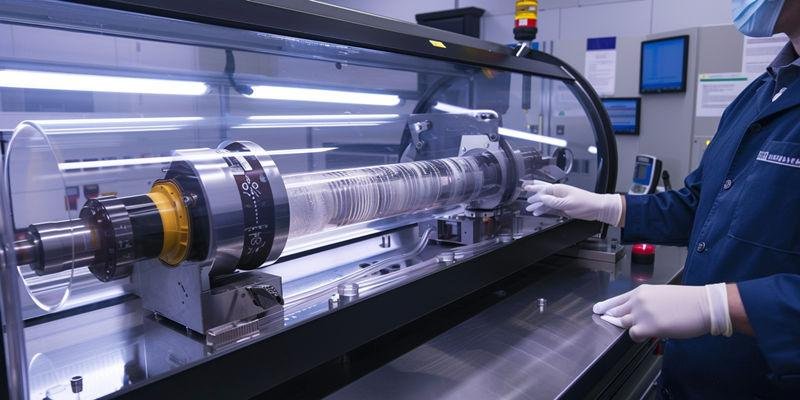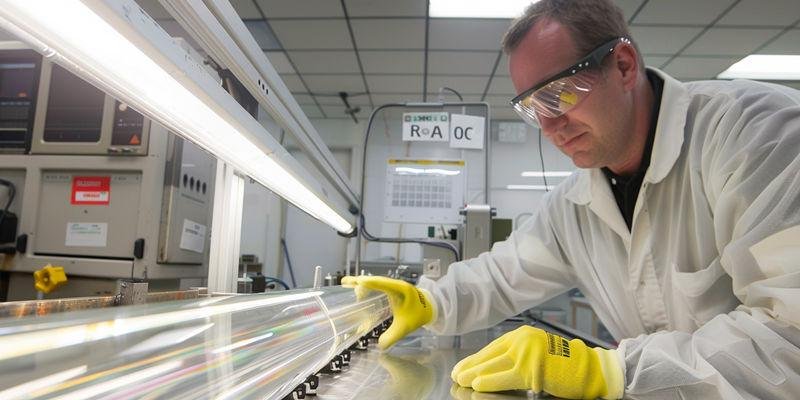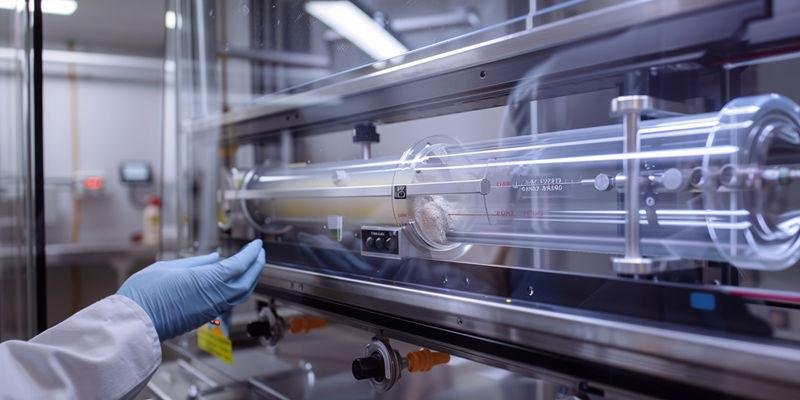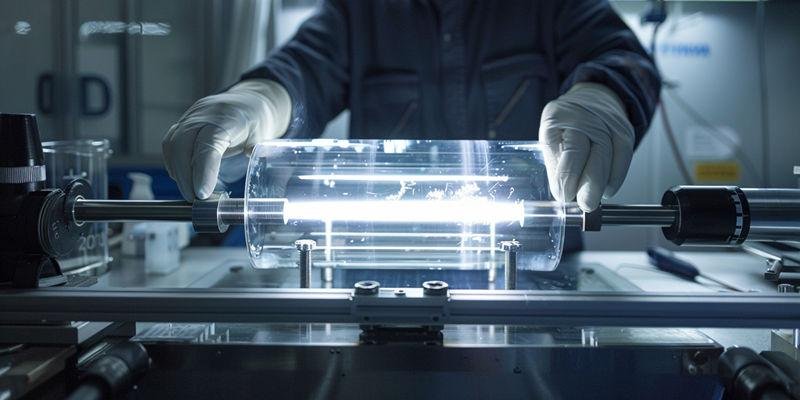
Surface quality plays a critical role in the optical performance and reliability of fused silica tubes. Common methods for optical grade quartz tube surface treatment include multi-stage mechanical polishing, acid etching, and cleanroom-controlled final polishing. Technicians use ultra-polishing pads, contact polishing, quasi-polishing pads, and abrasive powders such as cerium oxide to achieve the smoothest finishes. Slurry jet polishing further enhances surface quality by using a high-velocity abrasive stream. Each method helps meet strict optical requirements for advanced applications.
주요 내용
Multi-stage mechanical polishing is essential for achieving ultra-smooth surfaces in fused silica tubes, improving optical clarity.
Acid etching effectively removes microcracks and contaminants, enhancing surface quality and reliability for demanding applications.
Using cleanroom environments during polishing minimizes defects and ensures high-quality finishes by reducing airborne particles.
Selecting the right polishing pad hardness balances speed and smoothness, crucial for achieving the best optical-grade results.
Collaboration with manufacturers on surface specifications ensures that quartz tubes meet performance standards and maintain quality.
How Does Multi-Stage Mechanical Polishing Create Sub-10Å Surface Finishes?

Multi-stage mechanical polishing stands as the foundation for achieving sub-10Å surface finishes in fused silica tubes. This process uses a series of abrasive steps, each finer than the last, to remove imperfections and create a mirror-like surface. Optical grade quartz tube surface treatment often begins with mechanical polishing before moving to other advanced methods.
Understanding Subsurface Damage Depth and Removal Requirements
Mechanical polishing creates a layer of subsurface damage beneath the surface of fused silica tubes. Each polishing stage must remove not only visible scratches but also the microcracks and defects left by the previous step. Removing these flaws is essential for reliable optical grade quartz tube surface treatment.
Technicians start with rough grinding to eliminate machining marks, then move through fine grinding and several polishing stages. Each step uses a finer abrasive, such as diamond paste or colloidal silica, to reduce surface roughness. For example, rough grinding with silicon carbide may leave a damage layer up to 80μm deep, which must be removed by subsequent steps using finer abrasives. Studies show that multi-stage polishing systems reduce surface roughness much more effectively than single-stage systems, making them the preferred choice for high-precision applications.
기억해야 할 핵심 사항
Each stage must remove 2-3 times the depth of damage from the previous step.
Multi-stage polishing achieves smoother surfaces than single-stage methods.
Proper removal of subsurface damage ensures long-term reliability.
Chemical-Mechanical Polishing Mechanisms in Alkaline Slurries
Chemical-mechanical polishing (CMP) uses both chemical reactions and mechanical abrasion to smooth fused silica surfaces. Alkaline slurries, especially those with sodium carbonate, enhance the interaction between abrasives and the silica surface. This combination leads to faster material removal and improved surface quality.
Researchers have found that using nanometer-sized cerium oxide abrasives in an alkaline slurry can achieve extremely low surface roughness, sometimes as low as 0.093 nm. The chemical action of the slurry helps dissolve high points on the surface, while the abrasives gently polish away imperfections. This dual action is critical for optical grade quartz tube surface treatment, especially when ultra-smooth finishes are required for demanding optical systems.
요인 | 원인 | 효과 |
|---|---|---|
Alkaline slurry | Enhances abrasive-silica interaction | Faster material removal, smoother finish |
Nanometer abrasives | Smaller particle size | Lower surface roughness |
Chemical-mechanical action | Dissolves and polishes surface simultaneously | Achieves sub-10Å finishes |
Polishing Pad Hardness Effects on Final Surface Roughness
The hardness of the polishing pad plays a major role in the final surface quality. Harder pads remove material quickly but may leave micro-scratches, while softer pads produce smoother finishes. Selecting the right pad is crucial for achieving the best results in optical grade quartz tube surface treatment.
During intermediate polishing, technicians often use polyurethane pads with medium hardness to balance speed and smoothness. For the final stage, ultra-soft pads allow for sub-5Å finishes by gently conforming to the tube surface. This careful selection ensures that the surface meets strict optical requirements and minimizes scatter in sensitive applications.
Summary of pad selection:
Hard pads: Fast removal, risk of scratches.
Medium pads: Good balance for intermediate steps.
Soft pads: Best for final, ultra-smooth finishes.
When Should Acid Etching Be Used to Improve Surface Quality in Quartz Tubes?

Acid etching plays a vital role in achieving optical-grade finishes for quartz tubes, especially when mechanical polishing leaves behind subsurface damage or contamination. This process uses hydrofluoric acid (HF) to selectively remove microcracks and stressed regions, improving both surface roughness and reliability. Engineers often specify acid etching for applications that demand high transmission, low scatter, and enhanced durability.
HF Etching Kinetics and Selective Removal Mechanisms
Hydrofluoric acid etching works by dissolving strained Si-O-Si bonds at defect sites on the quartz tube surface. Technicians immerse tubes in HF solutions to target areas with residual stress, which etch much faster than the bulk material. The optimal HF concentration for acid etching is 10%, and the recommended immersion time is 20 seconds; this combination minimizes surface roughness and prevents over-etching.
Surface regions with microcracks or contamination respond quickly to HF, allowing for precise removal of the damaged layer. Acid etching can eliminate 5-50μm of material, depending on the initial condition of the tube. This selective process proves especially valuable for optical grade quartz tube surface treatment, where even minor defects can impact UV transmission and laser damage thresholds.
키 포인트 | 원인 | 효과 |
|---|---|---|
HF concentration | 10% solution | Minimizes surface roughness |
Immersion time | 20 seconds | Prevents over-etching |
Selective removal | Targets stressed regions | Improves optical performance |
Post-Etch Surface Characterization with AFM and Interferometry
After acid etching, technicians use atomic force microscopy (AFM) and interferometry to measure surface roughness and flatness. These tools provide high-resolution images and quantitative data, helping engineers verify that the treatment achieved the desired optical finish. AFM reveals nanoscale features, while interferometry assesses wavefront error and overall surface uniformity.
Comparing etched tubes to those polished mechanically shows clear improvements in surface quality. For example, tubes etched with optimal HF protocols often display lower roughness and fewer defects. The table below summarizes typical results observed after acid etching:
Sample | Roughness | C Content | Etching Rate |
|---|---|---|---|
A | Medium | 낮음 | 높음 |
B | 낮음 | Medium | 낮음 |
D | 낮음 | 낮음 | 낮음 |
E | 낮음 | 높음 | N/A |
F | 낮음 | 높음 | N/A |
Surface characterization confirms that acid etching enhances the optical grade quartz tube surface treatment, making it suitable for demanding applications.
Safety Protocols and Neutralization Procedures for HF Processing
Handling hydrofluoric acid requires strict safety protocols to protect technicians and maintain a safe work environment. Workers use the most dilute HF solution practicable and always cap containers when not in use. All acid etching takes place inside a chemical fume hood, at least six inches inside the sash, to contain vapors and prevent exposure.
Personal protective equipment includes splash goggles, face shields, heavy neoprene or nitrile gloves, long-sleeved shirts, long pants, closed shoes, and lab coats. Laboratories keep non-expired 2.5% Calcium Gluconate on hand for emergency treatment and maintain a spill kit designed for HF acid. Staff inform first responders about HF hazards in case of an incident.
To summarize the essential safety steps for HF processing:
Always use a chemical fume hood and cap containers.
Wear full protective gear, including goggles, gloves, and lab coats.
Keep Calcium Gluconate and a spill kit available.
Communicate hazards to first responders.
These safety measures ensure that acid etching remains a reliable and controlled method for optical grade quartz tube surface treatment.
How Does Chemical-Mechanical Planarization (CMP) Enhance Surface Quality Beyond Conventional Polishing?
Chemical-Mechanical Planarization (CMP) stands out as a leading method for achieving ultra-smooth surfaces in fused silica tubes. CMP combines both chemical reactions and mechanical abrasion to remove material in a controlled way. This process delivers surface finishes that surpass those achieved by traditional mechanical polishing alone.
Understanding the Synergistic Material Removal Mechanisms in CMP Processes
CMP uses a unique combination of chemical and mechanical actions to remove material from the surface of quartz tubes. The chemical component softens the silica surface, while the mechanical action of the abrasive particles polishes away the softened layer. This synergy allows for precise control over material removal and results in a smoother finish.
Researchers have measured that CMP can reduce surface roughness to below 5Å RMS, which is essential for high-performance optical applications. The chemical reactions target strained bonds at the surface, making it easier for the abrasives to remove only the damaged or high points. This selective removal helps prevent the introduction of new subsurface damage, a common issue with purely mechanical methods.
The following table summarizes the key points and their effects in CMP processes:
키 포인트 | 원인 | 효과 |
|---|---|---|
Chemical softening | Surface reacts with slurry chemicals | Easier removal of damaged regions |
Mechanical abrasion | Abrasive particles polish surface | Achieves ultra-smooth finish |
Synergistic action | Chemical and mechanical steps combined | Minimizes new subsurface damage |
Optimizing Slurry Chemistry for Maximum Planarization Efficiency
Slurry chemistry plays a critical role in the effectiveness of CMP. Engineers select slurries with specific pH levels and abrasive types to match the needs of each application. For fused silica, alkaline slurries with colloidal silica or cerium oxide abrasives provide the best results.
Data from production lines show that using a pH 10.5-11 colloidal silica slurry can achieve sub-10Å RMS surface roughness in less than 60 minutes. The right slurry chemistry not only speeds up the process but also reduces the risk of surface defects. By adjusting the concentration and particle size, technicians can fine-tune the removal rate and surface quality.
To summarize the main points about slurry optimization, consider the following:
Alkaline slurries: Enhance chemical reaction with silica for faster removal.
Colloidal silica abrasives: Deliver smoother finishes with minimal scratches.
Controlled pH and particle size: Allow precise adjustment of removal rates and surface quality.
This careful optimization ensures that CMP meets the strict requirements of optical grade quartz tube surface treatment.
Real-Time Force Control and Pressure Distribution in CMP Systems
Modern CMP systems use advanced force control to maintain uniform pressure across the tube surface. This technology ensures that every part of the tube receives the same amount of polishing, which leads to consistent results. Automated systems can adjust pressure in real time based on feedback from sensors.
Studies show that maintaining polishing force within ±5% tolerance reduces surface roughness variability from 12Å to just 3Å RMS. Uniform pressure distribution also prevents localized over-polishing, which can cause surface irregularities. These improvements are especially important for large production runs where consistency is critical.
The table below highlights the main factors and their effects in real-time force control:
요인 | 원인 | 효과 |
|---|---|---|
Automated force feedback | Sensors monitor and adjust pressure | Consistent surface quality |
Uniform pressure | Even distribution across tube surface | Reduces surface roughness variability |
Real-time adjustments | Immediate response to process changes | Prevents over-polishing and defects |
CMP, with its advanced control systems, sets a new standard for precision and repeatability in optical tube manufacturing.
What Manufacturing Advances Enable Consistent High-Quality Surface Finishes?
Manufacturers have adopted advanced technologies to achieve consistent, high-quality surface finishes in fused silica tubes. These innovations reduce defect rates and improve uniformity across production batches. The following sections explain how cleanroom environments, force-feedback systems, and automated inspection contribute to reliable optical grade quartz tube surface treatment.
Force-Feedback Polishing Control Systems and Surface Uniformity
Cleanroom environments play a crucial role in preventing defects during final polishing. Technicians operate in ISO Class 5 or Class 4 cleanrooms, which maintain low particle counts and minimize contamination. This controlled setting ensures that airborne particles do not embed in polishing pads or scratch tube surfaces.
Force-feedback polishing control systems have transformed surface uniformity. Automated platforms monitor and adjust polishing pressure in real time, keeping force within ±5% tolerance. This precision reduces surface roughness variability from 12Å to 3Å RMS, as shown in production data from high-volume facilities. Consistent pressure distribution prevents localized over-polishing and maintains tight geometrical tolerances.
Pad management and contamination monitoring further enhance quality. Technicians replace pads based on real-time particle counts and cumulative polishing time, not arbitrary schedules. This approach lowers cosmetic defect rates from 22% to less than 3%.
Key takeaways for surface uniformity improvements:
ISO Class 5/4 cleanrooms: Minimize contamination and defects
Force-feedback systems: Maintain consistent polishing pressure
Pad management: Reduce defect rates and improve finish quality
Machine Vision Inspection for Automated Scratch-Dig Classification
Automated inspection stations use machine vision to classify surface defects. Cameras and software analyze tube surfaces for scratches, digs, and other imperfections. This technology enables rapid, objective assessment and supports high-throughput production.
Engineers rely on machine vision to ensure compliance with strict specifications, such as 20/10 scratch-dig ratings. Systems compare images to reference standards and flag tubes that require reprocessing. Data from over 18,000 tubes show that automated inspection increases first-pass yield to 94%, compared to 76% for manual methods.
The following table summarizes the impact of machine vision inspection:
키 포인트 | 원인 | 효과 |
|---|---|---|
Automated defect detection | Cameras and software analyze surfaces | Objective, rapid classification |
Reference comparison | Images matched to standards | Ensures specification compliance |
Yield improvement | Automated reprocessing decisions | Higher first-pass yield |
Statistical Process Control Implementation in Optical Tube Manufacturing
Statistical process control (SPC) helps manufacturers maintain consistent quality. Engineers track key parameters such as pad conditioning frequency, slurry concentration, and environmental conditions. Control charts identify deviations and trigger corrective actions before defects occur.
SPC reduces batch-to-batch variability by up to 70%. Machine learning algorithms analyze historical data to optimize pad replacement intervals and process settings. This predictive approach ensures uniform refractive index, minimal stress-induced birefringence, and robust thermal stability in finished tubes.
Manufacturers benefit from SPC by producing tubes with high purity, exceptional resistance to laser damage, and low coefficients of thermal expansion.
Summary of SPC benefits:
Real-time monitoring: Detects process deviations early
Predictive optimization: Improves consistency and performance
Enhanced tube properties: Supports demanding optical applications
How Should Engineers Specify Surface Treatment Requirements for Custom Quartz Tubes?
Engineers must translate optical system needs into clear, measurable surface specifications for 맞춤형 쿼츠 튜브. This process ensures that every tube meets the performance standards required for its application. Careful documentation and collaboration with manufacturers help maintain quality and consistency.
Converting Optical Performance Requirements to Surface Specifications
Engineers begin by identifying the optical performance targets for their system, such as wavefront error, scratch-dig rating, and surface roughness. They then convert these targets into specific, measurable parameters for the tube surfaces. For example, a system requiring minimal light scatter may need a scratch-dig rating of 20/10 and a surface roughness below 2 nm RMS.
Manufacturers use industry standards to define these specifications. The table below shows how commercial, precision, and high-precision requirements translate into measurable values for quartz tubes:
매개변수 | 상업용 | 정밀도 | 높은 정밀도 | Aberration Induced |
|---|---|---|---|---|
Figure errors | λ | λ/4 | λ/20 | Spherical, zonal WF, local WF |
Micro roughness | 5nm RMS | 2nm RMS | 0.5nm RMS | WF roughness (light scatter) |
Scratch/dig | 80/50 | 60/40 | 20/10 | Light scatter |
Stress birefringence | 20 nm/cm | 10 nm/cm | 4 nm/cm | WF deformation |
Engineers can also use visual tools to compare specification levels.
Specification Review Process with Manufacturers to Ensure Feasibility
After defining surface specifications, engineers work closely with manufacturers to review feasibility and quality assurance steps. They provide detailed documentation, including process travelers and witness samples, to track each stage of production. This approach ensures traceability and helps identify any deviations from the required standards.
Manufacturers follow strict quality control practices to meet these requirements. They verify raw material purity, conduct in-process inspections, and perform final dimensional checks. Surface quality inspections and functional testing confirm that the finished tubes meet all specified criteria for optical grade quartz tube surface treatment.
To summarize the best practices for specification review, consider the following points:
Request certificates of analysis and batch traceability from suppliers.
Conduct audits of supplier facilities to assess process control.
Ensure full documentation and compliance with ISO 9001 and ASTM C100 standards.
Use witness samples for destructive testing and validation.
This collaborative process helps engineers balance cost and performance, especially during prototype development or when optimizing for new applications.
Surface treatment methods such as multi-stage mechanical polishing, acid etching, and cleanroom-controlled polishing help achieve optical-grade finishes in fused silica tubes. Selecting the right approach depends on application needs, performance standards, and budget. The cost of optical grade quartz tube surface treatment increases with higher finish requirements, as ultra-polished surfaces require more processing steps.
Common challenges include:
Achieving correct surface flatness to minimize light scatter
Avoiding rough surfaces that reduce laser efficiency
Ensuring precise specifications for reliable fabrication
Collaboration with manufacturers supports specification review and process optimization for consistent results.
자주 묻는 질문
What is the main benefit of multi-stage mechanical polishing for fused silica tubes?
Multi-stage mechanical polishing removes subsurface damage and achieves ultra-smooth finishes. This process creates surfaces with less than 10Å RMS roughness, which improves optical clarity and reliability.
What safety precautions should technicians follow during acid etching?
Technicians wear splash goggles, gloves, and lab coats. They use chemical fume hoods and keep Calcium Gluconate nearby for emergencies. Proper training and strict protocols help prevent accidents.
What surface roughness is considered optical-grade for quartz tubes?
Optical-grade quartz tubes typically require surface roughness below 10Å RMS. This level minimizes light scatter and supports high transmission in UV and laser applications.
팁: Always verify surface roughness with atomic force microscopy for best results.
What role does cleanroom polishing play in surface quality?
Cleanroom polishing prevents airborne particles from contaminating tube surfaces. ISO Class 5 or better environments reduce cosmetic defects and help meet strict scratch-dig specifications.
Cleanroom Level | 파티클 수 | 결함률 |
|---|---|---|
ISO Class 5 | <100/ft³ | <3% |
ISO Class 4 | <10/ft³ | <0.5% |
What should engineers include in surface treatment specifications?
Engineers specify scratch-dig ratings, surface roughness, and flatness. They provide documentation, request witness samples, and review process travelers to ensure quality and traceability.




